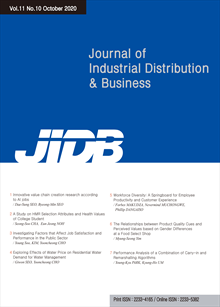간행물
산경연구논집 (JIDB) KCI 등재 산경연구논집 The Journal of Industrial Distribution & Business (JIDB)

- 발행기관 한국유통과학회
- 자료유형 학술지
- 간기 월간
- ISSN 2233-4165 (Print)2233-5382 (Online)
- 수록기간 2010 ~ 2020
- 주제분류 사회과학 > 경영학 사회과학 분류의 다른 간행물
- 십진분류KDC 325DDC 330
권호리스트/논문검색
Vol. 5 No. 2 (2014년 6월) 4건
1.
2014.06
서비스 종료(열람 제한)
Purpose - The purpose of this thesis is to assess the product design digital learning status of universities that are currently involved in learning environment projects in manufacture and commerce integration (MCI). Thus, enterprises must keep learning and creating new inventions with revolutionary progress. Research design, data, and methodology - This study not only emphasizes the analysis of technical ability, course concepts, conducting models, and learning environments of every aspect, but also systematically probes the planning of learning, system framework, web learning, environmental activities, data statistics, and digitalized learning, among other aspects. Results - The results of this study help in finally understanding each school’s manufacture and commerce integration situation, in order to evaluate product design learning. Consequently, it is essential to evaluate computer learning at schools, thereby affecting communication and the requirements of business education training. Conclusions - It is essential to focus on MCI to promote web teaching to preserve and enhance knowledge disseminating technologies, and immediately share knowledge with learners, while improving work efficiency and cultivating the talent needed by industry.
2.
2014.06
서비스 종료(열람 제한)
Purpose The purpose of this – study is to empirically investigate the impact of capital structure on firm performance. Research design, data, and methodology – This study examined the impact of capital structure on the performance of cement companies listed on the Karachi Stock Exchange during the period 2009-2013. The authors hypothesize that there is a negative relationship between capital structure and firm performance. To examine the association, the authors run a Pearson correlation and multiple regression analysis. Results – Results reveal a strong negative relationship between debt to asset and firm performance variables (GPM, NPM, ROA, and ROE). Further, there is a positive relationship between debt to equity and firm performance variables (GPM and NPM), anda negative relationship between debt to equity and firm performance variables (ROA and ROE). Moreover, capital structure variables significantly impact firm performance. Conclusions – This study concluded that financial analysts and managers should emphasize on the optimal level of capital structure and efficient utilization and allocation of resources to achieve the targeted level of productive efficiency in business
3.
2014.06
서비스 종료(열람 제한)
Purpose - This study aims to understand the brand marketing of agricultural products and redefine their status in South Korea by analyzing impacts on consumer buying behaviors. Research design, data, and methodology - Products, with independent variables, were divided into agricultural brand products and generic products. Dependent variables were limited to expanding sales of a specialty brand through consumer awareness, consumer buying behavior, and confidence in agricultural products’ quality. Control variables were based on characteristics of products such as freshness, safety, quality, and their category. Moderating effects were examined on consumer characteristics, including income levels and age. Results - Consumers increasingly purchased agricultural brand products rather than generic agricultural products because of the general reliability of quality assurance. Conclusions - Large agricultural specialty stores have enhanced the perceptions of quality assurance, freshness, safety, and diversity. Through a critical analysis of the domestic consumer income levels and age, gender, and demographic factors, such as agricultural consumer buying behavior not affecting consumers' health and life, this study proposes positive changes in quality perception.
4.
2014.06
서비스 종료(열람 제한)
James Madzimure, Ntombizodwa Bovula, Grace P.K. Ngorora, Obert Tada, Shelton M. Kagande, Archibold G. Bakare, Michael Chimonyo
Purpose - The study aimed to evaluate the market opportunities and constraints confronting resource-poor pig farmers in South Africa. Research design, data, and methodology - Information was collected from 292 households in three municipalities through interviews with key informants. The data collected included socio- economic characteristics, major market channels, prices for different pig classes, average weight of the pigs on sale, number of pigs sold annually, and preferred meat quality attributes. Results - In Ngqushwa, 96% of respondents sold pigs as compared to Elundini (81%) and Ntabankulu (65%). Less resource- poor households and those with market-oriented production had large herdsizes (P < 0.05) when compared to more resource-poor farmers. The probability of selling pigs was high for the backyard production system and educated farmers. For all farmers, opportunities included high pork demand, good prices, employment creation, and a niche market for organically produced indigenous pork. Constraints include disease, feed shortages for large herds, distances to formal markets, lack of training, and drugs. Conclusions - Constraints outnumbered opportunities for the resource-poor pig farmers

